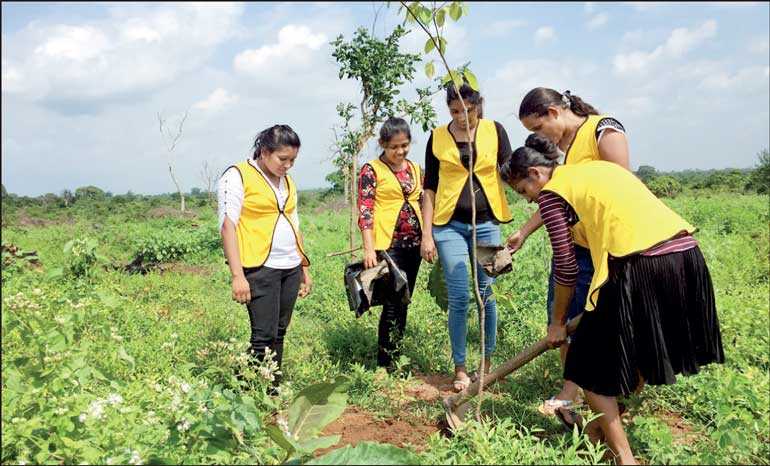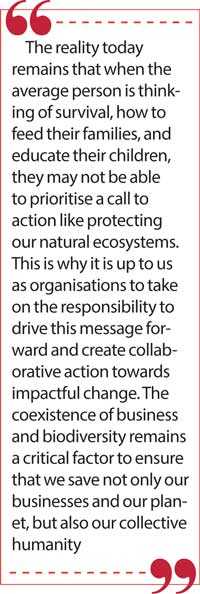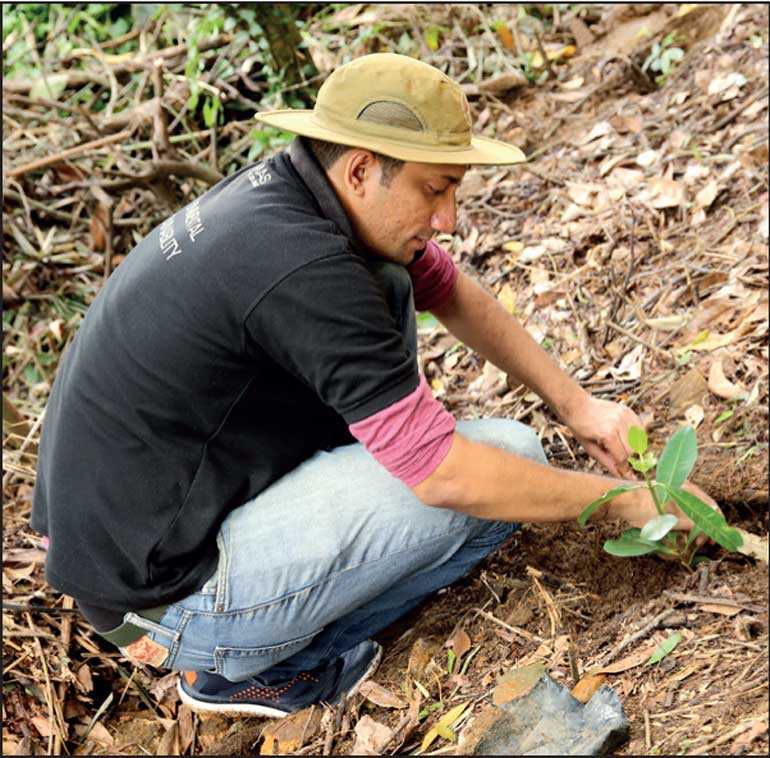Friday Mar 14, 2025
Friday Mar 14, 2025
Wednesday, 25 November 2020 00:00 - - {{hitsCtrl.values.hits}}

The rapid spreading of the invasive species Lantana in Udawalawe National Park has caused a depletion of biodiversity, species richness and food productivity. Since 2018, MAS has been removing these invasive bushes from the park with the supervision of the Wildlife Department of Sri Lanka. Currently, under this project, Lantana has been removed from a total area of 567 acres of the park, along with the concurrent planting of native trees to encourage the local vegetation to return faster as the invasive trees were being removed
As a young child growing up, I was privileged to have a family with a passion for agriculture. Even as an 11-year-old, I was entrusted with my flowers and vegetable plots, heavily influenced by parents and  grandparents who inculcated a love for growing within me. This helped me to develop an appreciation of the natural world and its many gifts from an early age which has influenced the decisions I take today, both as an individual and a business leader.
grandparents who inculcated a love for growing within me. This helped me to develop an appreciation of the natural world and its many gifts from an early age which has influenced the decisions I take today, both as an individual and a business leader.
When accounting for long-term business survival, one usually doesn’t consider the heavy cost to biodiversity and nature, specifically on plant and animal life. The relationship between business and biodiversity has traditionally been a tricky one. Can both exist simultaneously or are they mutually exclusive, where biodiversity is usually given the rough hand out of the two? Businesses have been known to contribute to the loss of biodiversity and natural ecosystems, and recent events have shown us that the corporate world has an immense responsibility to start strengthening the connection that we have with our surrounding ecosystems.
The threaded links between business and biodiversity
It comes as no surprise that the imbalance between business success and the degradation of natural life is severe and tipping dangerously to one side. Global temperatures are rising, glaciers are diminishing, and natural resources are being depleted on a day-to-day basis. Unfortunately, this does not even begin to scratch the surface. The apparel industry has been labelled as one of the biggest polluters globally, with issues such as post-consumer waste, degradation of biodiversity, deforestation and water pollution spanning across supply chains, manufacturing and consumer use.
But what we may not realise is that business itself needs natural lifecycles to survive and thrive. Protecting biodiversity, be it pollination, regeneration, filtration and all other natural life cycles of plants and animals, ensures that businesses can enjoy long and healthy lives. The process of manufacturing garments depends on agriculture for natural yarns and fabrics. We disrupt our ecosystems and the resulting imbalance causes chaos in the food chain, which negatively impacts our industry. The result is supply disruptions in acquiring cotton, wool, natural bamboo and other natural fibres, with the cost of recreating the natural fibres eventually becoming unsustainable.
How do we strengthen this tenuous relationship between business and biodiversity where both  phenomena can coexist successfully? Three words: education, education, education. As our actions continue to harm the planet, we must be educated and continuously reminded of our role and responsibility to protect, and not pollute. The reality remains that businesses are a reflection of its people and when those in leadership positions fully grasp the impact and importance of protecting our environment, that thinking will trickle down the hierarchy and positively influence how businesses are run.
phenomena can coexist successfully? Three words: education, education, education. As our actions continue to harm the planet, we must be educated and continuously reminded of our role and responsibility to protect, and not pollute. The reality remains that businesses are a reflection of its people and when those in leadership positions fully grasp the impact and importance of protecting our environment, that thinking will trickle down the hierarchy and positively influence how businesses are run.
Value chain impacts
With tremendous reach through employees, partners and channels of communication, businesses have a significant responsibility to distribute knowledge to the general public and to the nation as a whole. In our journey at MAS, we as leaders have taken this responsibility to heart and take every effort to incorporate sustainability thinking into all aspects and levels of the organisation. We have learnt that the importance of biodiversity conservation can be taught just as any other work-related concept: through workshops, trainings, and knowledge sharing efforts by experts in the field. Even the process of disposing apparel waste is used as a learning opportunity for employees to understand how we can create value through waste. As leaders, we must openly embrace and demonstrate this kind of thinking and inculcate this into the value streams across all levels of the business.
Globally, supply chains have a historically negative reputation of contributing to the loss of biodiversity. But businesses must work towards changing this by collaborating with suppliers and other value chain partners to create sustainable sourcing options and a transparent supply chain. All the supplier organisations in our value chain, be it for yarn, fabric, or any other raw material, must adhere to our supplier standards prior to any vendor agreement. If suppliers do not yet qualify, we work together to elevate and strengthen their standards in order to meet the required certification.
Sustainability is prioritised at the same level as revenue and profit, from our manufacturing process up to the customer interface. We have seen our strategic brand partners such as lululemon openly and proactively embrace commitments to conserve the environment. Another beacon in the apparel industry is Patagonia, which is a brand that has often been a source of inspiration. It is an organisation that has stood true to its values and built itself on the foundation of doing things differently and working to address the threats that the world faces, whether it be through their products, processes, or people. Their “Worn Wear” initiative is a prime example of their commitment to sustainability, through which they repair products for longer use, and recycle any products which are beyond repair. Their mission is no longer just to “do no harm” to the environment, but to proactively engage in doing good.
Conservation vs development
Zooming into our little island nation, Sri Lanka has seen its fair share of conversations around the impact on biodiversity and habitats in certain parts of the nation. Over the years, there have been many conversations about biodiversity hotspots being compromised for economic development. The recent discussion around the Sinharaja Forest Reserve has been an important one with many different factors to consider.
Preserving the home of 60% of the nation’s endemic flora and fauna is of utmost importance. It is equally important to ensure that the local communities do not miss out on the benefits of economic development, such as easier access to schools, health care, and other facilities. As a nation, we must consider intelligent solutions to simultaneously develop and conserve.
A number of regions across Sri Lanka, such as Gal Oya, Knuckles Range, Ella, Little Adams Peak and the Bible Rock area have monetised their natural reserves by focusing on activities such as trekking, climbing, hiking and conversing with professional naturalists to help understand and appreciate the plant and animal life in those areas. As visitors and admirers of these spaces, the public also has a considerable responsibility to ensure that we keep them safe and clean and do no harm to these unique ecosystems.
The role of activism
Historically, there has always been a conflict of opinions and interests between businesses and activists when it comes to protecting biodiversity. However, it is important to acknowledge and respect those in society calling for change and action. Everyone has a right to voice their own opinion and activists are crucial in highlighting the important matters and calling out those who are in the wrong. However, only spotlighting the problems is not enough to bring about change. People should call out issues but also support the process of problem-solving by bringing a set of solutions or options to the table so both businesses and activists can collaborate and work together to address the challenges that our planet currently faces.
Conserving biodiversity: The challenges
While there exists a number of challenges in conserving biodiversity, a muted mindset is a critical issue that can prevent this topic from becoming mainstream. Changing ingrained behaviours and mindsets is an immense undertaking. The process of unlearning and relearning the most basic foundation of being kind to the environment is a heavy one. Older generations are likely to be set in their ways while the younger folks tend to acknowledge the need of the hour and respond faster. Creating spaces where both parties can converse and combine ideologies can positively influence the mindset change process.
We must first consider the root of the problem. We may not have naturally ingrained environmental thinking because we simply have not been taught to do so. In the past, formal learning may not have directly emphasised protecting, conserving and appreciating the natural ecosystems around us. While we see this changing now, individuals may not have had the opportunity to formally integrate this into our learning in the past. Of course, homes and communities also have important roles to play in a child’s learning and in inculcating these behaviours. As a child, I was heavily influenced by the practices at home, with my passion for the environment and wildlife starting within the home as a young child.
In addressing conservation, it is also important to plan and act smart. In the latter part of the 18th century, eucalyptus trees were introduced to Sri Lanka, and expanded into upcountry plantations in the 1930s as windbreakers. While eucalyptus offered a host of commercial and environmental benefits, it also contributed to the degradation of the undergrowth, and therefore disturbed the natural ecosystems. Therefore, we must think smartly about the actions we take to conserve and protect our biodiversity. Our agenda should not just be to simply plant more trees in attempts of reforestation. We must consider what trees can provide the most value to our ecosystems through their ecological services, and which species are best suited for that area, topography, soil, and weather patterns.
Driving change: The business responsibility
When an organisation employs a significant number of people, it has the capability and influence to do the right thing by sharing information and proliferating the message of conservation throughout society. We also have the responsibility to do all that we can to create the change that we want to see.
As part of our Group sustainability strategy, MAS pledged to restore habitats and enhance ecosystems in 100x the area that we occupy, thereby restoring 25,000 acres of habitat by 2025, an immense task all on its own. Four years in, we have made good on restoring 1,700 acres, but we recognise that the journey is a long one and requires many collaborators to come together to achieve success.
Addressing the underlying need to continuously educate employees and communities on the holistic concept of protecting biodiversity is paramount, and this is something we continue to drive progress on through programmes like the Eco Go Beyond sustainable education programme for school children.
The reality today remains that when the average person is thinking of survival, how to feed their families, and educate their children, they may not be able to prioritise a call to action like protecting our natural ecosystems. This is why it is up to us as organisations to take on the responsibility to drive this message forward and create collaborative action towards impactful change. The coexistence of business and biodiversity remains a critical factor to ensure that we save not only our businesses and our planet, but also our collective humanity.

Yagirala Forest Reserve is a lowland, tropical, wet evergreen forest located in the Kalutara District. The University of Sri Jayewardenepura has been managing a 100-acre block of the Yagirala Forest Reserve for research and education purposes. MAS partnered the University to mitigate deforestation occurring due to encroachment and illegal logging, through a forest restoration program, restoring over 17 acres of degraded lands and developing a five-acre herbal garden within the forest reserve

Aerial reforestation or ‘seed bombing’ is a technique of sowing forest plant seeds by spraying them through aerial mechanisms, such as a drone, plane or helicopter, reaching areas which would otherwise be inaccessible on ground. MAS piloted seed bombing in Sri Lanka with the help of partners like the Sri Lanka Air Force, the Department of Forests and the University of Peradeniya. When species composition and the conditions of the reforestation site are aligned, seed bombing can be a very successful method of restoring habitats at a large scale
(The writer is the Chief Executive Officer of MAS Active and a board member of MAS Innovation. He is a veteran in the apparel industry who has mastered the intricacies of apparel manufacture, and leads a team of almost 10,000 employees in various parts of Sri Lanka and Haiti, to partner customers such as lululemon, Gymshark, Lacoste, Ralph Lauren and Patagonia. He cites his entrepreneurial nature and experience at the Stanford Graduate School of Business as having been instrumental to his success in business. This article is co-authored by Chelan Goonetilleke and Nitya Amalean.)
Discover Kapruka, the leading online shopping platform in Sri Lanka, where you can conveniently send Gifts and Flowers to your loved ones for any event including Valentine ’s Day. Explore a wide range of popular Shopping Categories on Kapruka, including Toys, Groceries, Electronics, Birthday Cakes, Fruits, Chocolates, Flower Bouquets, Clothing, Watches, Lingerie, Gift Sets and Jewellery. Also if you’re interested in selling with Kapruka, Partner Central by Kapruka is the best solution to start with. Moreover, through Kapruka Global Shop, you can also enjoy the convenience of purchasing products from renowned platforms like Amazon and eBay and have them delivered to Sri Lanka.
Discover Kapruka, the leading online shopping platform in Sri Lanka, where you can conveniently send Gifts and Flowers to your loved ones for any event including Valentine ’s Day. Explore a wide range of popular Shopping Categories on Kapruka, including Toys, Groceries, Electronics, Birthday Cakes, Fruits, Chocolates, Flower Bouquets, Clothing, Watches, Lingerie, Gift Sets and Jewellery. Also if you’re interested in selling with Kapruka, Partner Central by Kapruka is the best solution to start with. Moreover, through Kapruka Global Shop, you can also enjoy the convenience of purchasing products from renowned platforms like Amazon and eBay and have them delivered to Sri Lanka.